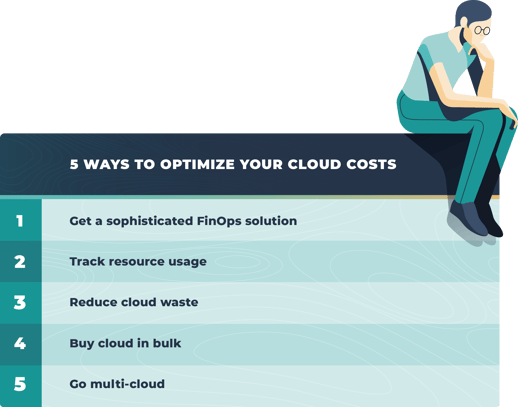Cloud Cost Optimization: best practices for reducing your cloud bill
The tech industry is not having a great time at the moment. The 5 US tech giants – Microsoft, Google, Apple, Meta, and Amazon – have reported losses in 2022 for the first time in years, and announced massive job layoffs. Of course, they’re by no means going bankrupt, still having earned a combined $243 billion, but seeing as this figure is slightly lower than in 2021, this is sending executives (and the tech industry as a whole) into panic mode (as if it’s not at all a sign of people getting fed up with living in late-stage capitalism).
With major companies bringing back efficiency and profitability, more and more businesses are talking about squeezing budgets in light of the cost of living crisis and the slowing global economy. If you’re considering cutting excess weight in your spreadsheets, here’s a suggestion – why not take a look at your cloud spending?
If 2023 is supposed to be “the year of efficiency”, optimizing your cloud usage is one to start. Not only do cloud costs make up almost 41% of the IT budget according to Gartner – meaning cutting it would make a real difference to your overall finances – in most cases, a lot of the cloud ends up being wasted. Our founder Benjamin Brial has written on the subject of cloud waste before, but the TL:DR is this: despite the cost of the cloud going down, companies’ spending on it has doubled in the last few years, with over $26 billion wasted on inefficient cloud usage. For a hyper-efficient IT world, it’s terribly below the mark.
If any of this rings true, don’t despair – there are ways to cut your spending and optimize cloud usage.

Get good FinOps software to track your costs
One of the reasons cloud spending keeps rising is the fact that cloud costs are shrouded in complexity and mystery, and traditional ways of monitoring them just don’t cut it anymore. Tracking with spreadsheets can get really complicated really fast while chasing data around multiple cloud cost management solutions across your cloud providers is already unnecessarily complex and can mask the real culprits.
What you must be looking for in a FinOps tool is the level of data granularity. You must be able to see the cost breakdown by project, region, provider, date range, or even team, to identify blindspots and money suckers, which would normally be overlooked.
Centralization and ease of access also play a part: the faster you can get a bird's eye view of your cloud usage, the easier it is to correct course in case of errors. Marketing departments have ruined the word “holistic” for the world, but it’s exactly what you should be aiming for because getting the big picture, trends, and predictions for cloud resources can be the real missing piece to your financial strategy.
This is perhaps where we could plug our own FinOps module Cloud Cost Management, which does all of the above, but the consumer choice is really up to you – we can only advise on what to look out for.
Resource management
.png?width=346&height=250&name=KPIs%20(1).png) If your developers are enjoying the benefits of a self-service portal, resource management and access controls are a must. When end-users are servicing themselves, it’s really easy to spend more on cloud resources than you initially budgeted for, so it’s best to use a quota system.
If your developers are enjoying the benefits of a self-service portal, resource management and access controls are a must. When end-users are servicing themselves, it’s really easy to spend more on cloud resources than you initially budgeted for, so it’s best to use a quota system.
Think about setting up resource limits in advance and assign quotas to teams to make sure they keep to the budget. Additionally, providing cost visibility to end-users directly can help them make more conscious decisions and foster a culture of independence and transparency.
Understanding the consequences of these specific decisions and calculating the impact they will have on the bottom line, ahead of time, is critical. For example, a cost estimation feature built into your self-service portal will let your end-users know the cost of their new deployments in advance so that they manage to keep within budget constraints. TerraCost, Cycloid’s open-source project uses your Terraform plan to automatically display the cost of a new environment before it’s deployed and can be used by any self-servicing team.
Reduce cloud waste with a sobriety mindset We’ve mentioned before about cloud waste, but the real change goes beyond just using the right tools - it requires a mindset shift across the whole organization. Some more horrifying statistics: according to the HashiCorp State of Cloud Strategy Survey, 40% of companies overspent their cloud budgets in 2021. This means that nearly half of all companies don’t make enough of an effort to promote healthy cloud practices in their organization or monitor cloud consumption.
We’ve mentioned before about cloud waste, but the real change goes beyond just using the right tools - it requires a mindset shift across the whole organization. Some more horrifying statistics: according to the HashiCorp State of Cloud Strategy Survey, 40% of companies overspent their cloud budgets in 2021. This means that nearly half of all companies don’t make enough of an effort to promote healthy cloud practices in their organization or monitor cloud consumption.
For far too long businesses have viewed the cloud as an unlimited resource needed to drive progress forward with no regard for the financial and environmental costs. While it still is a major driver of technological growth, there are ways to use it more efficiently – and it starts with a change mindset.
Adopt sobriety practices: turn off infrastructure during the weekend. Empower your end-users to make informed decisions about the amount of cloud they’re using and its impact. Stop over-provisioning resources.
An additional bonus of looking after your cloud usage is its lowered impact on the environment and reduced cloud carbon footprint – a lovely pat on the back for your organization and team.
Buy in bulk
Reserved instances are a great way to get major discounts on your cloud and save some cash. If your business has a steady workload, you can simply commit to a cloud volume over time and get over 50% in discounts. This will depend on the amount and length of the commitment, as well as how much you need to pay in advance, but it’s a great way to “deploy within your means” and stop overspending.
Most major public cloud providers already offer various options for reserved instances, but before you run and stock up, think about vendor lock-in.
Consider multi-cloud to avoid vendor lock-in
AWS, Microsoft Azure and Google Cloud are all also facing slowing profit margins, so their main goal is to entrench themselves with the customer or in other words, lock them in. According to Financial Times, AWS is offering big discounts to clients that use them exclusively potentially squeezing out smaller competitors. Terms like “preferred cloud provider” or “all in” are designed to make you commit to spending a large amount of money without considering other cloud providers.
While discounts are great in the short term, using a single cloud vendor may not be the best option for your business long-term. We prefer not to put all our eggs in one basket, because a hybrid or multi-cloud approach strives for flexibility, agility, and speed, which will not only address the cloud cost concerns but also help your business be more profitable in the long run.
Cloud cost optimization is an ongoing project
Optimizing cloud usage should be happening continuously at all levels of business to achieve the best results. This is not the case of implementing cost-saving strategies once - your cloud costs must be constantly monitored, analyzed and practices improved to boost efficiency.
Even though things might be tough, and for most major companies employees are the first ones on the cutting block, the more forward-thinking businesses should first look at their inefficient processes and tools before initiating big layoffs.
At the end of the day, taking better control of your cloud spending and consequently, cloud carbon footprint will have a positive effect on your accounts and the environment.
Read More
Cloud Carbon Footprint: a GreenOps + FinOps approach to cloud waste
Cycloid is proud to present Cloud Carbon Footprint, our own cloud carbon emissions module...Cloud cost management - FinOps just got built-in!
Cycloid's delighted to launch their cloud cost management module, the next iteration of Cost...A Cycloid offer that might be the chance your business needs to thrive
When coronavirus broke out - or coronageddon, as I like to call it - Cycloid quickly decided to...©2015-2022 Copyright Cycloid.io | Legal Notice



